
A diatom is any member of a large group comprising several genera of algae, specifically microalgae, found in the oceans, waterways and soils of the world. Living diatoms make up a significant portion of the Earth's biomass: they generate about 20 to 50 percent of the oxygen produced on the planet each year, take in over 6.7 billion tonnes of silicon each year from the waters in which they live, and constitute nearly half of the organic material found in the oceans. The shells of dead diatoms can reach as much as a half-mile deep on the ocean floor, and the entire Amazon basin is fertilized annually by 27 million tons of diatom shell dust transported by transatlantic winds from the African Sahara, much of it from the Bodélé Depression, which was once made up of a system of fresh-water lakes.
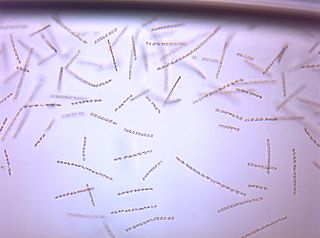
Chaetocerotaceae is a diatom family (Bacillariophyta). This family comprise the three genera Attheya T. West, Bacteriastrum Shadbolt and Chaetoceros Ehrenberg. Chaetoceros is perhaps the largest and most species rich genus of marine planktonic diatoms. The taxonomic status within Chaetocerotaceae at present is somewhat unclear.

Chaetoceros is a genus of diatoms in the family Chaetocerotaceae, first described by the German naturalist C. G. Ehrenberg in 1844. Species of this genus are mostly found in marine habitats, but a few species exist in freshwater. It is arguably the common and most diverse genus of marine planktonic diatoms, with over 200 accepted species. It is the type genus of its family.

Chaetoceros furcellatus is an Arctic neritic diatom in the genus Chaetoceros. The easiest way to identify this species is by finding the very characteristic resting spores. C. furcellatus is a common and important species in the Barents sea.
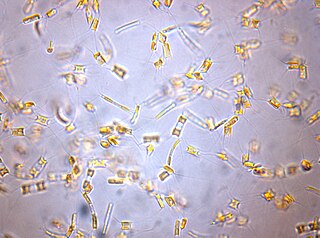
Attheya is a genus of small single celled diatoms. Some of these species were earlier regarded to belong to Chaetoceros, or to Gonioceros, the taxonomic status of some of these species are still debated.

Ochrophytes, also known as heterokontophytes or stramenochromes, are a group of algae. They are the photosynthetic stramenopiles, a group of eukaryotes, organisms with a cell nucleus, characterized by the presence of two unequal flagella, one of which has tripartite hairs called mastigonemes. In particular, they are characterized by photosynthetic organelles or plastids enclosed by four membranes, with membrane-bound compartments called thylakoids organized in piles of three, chlorophyll a and c as their photosynthetic pigments, and additional pigments such as β-carotene and xanthophylls. Ochrophytes are one of the most diverse lineages of eukaryotes, containing ecologically important algae such as brown algae and diatoms. They are classified either as phylum Ochrophyta or Heterokontophyta, or as subphylum Ochrophytina within phylum Gyrista. Their plastids are of red algal origin.

Chaetoceros diadema is a diatom in the genus Chaetoceros. The easiest way to identify this species is by finding the very characteristic diadem-like resting spores.
Craticula is a genus of diatom that lies on or in the top layers of sediments in the freshwater to brackish water environments it inhabits. In addition to frustule morphology the genus differs from closely related species by its sexual reproduction and movement in response to light.
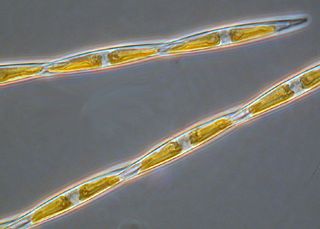
Pseudo-nitzschia is a marine planktonic diatom genus that accounts for 4.4% of pennate diatoms found worldwide. Some species are capable of producing the neurotoxin domoic acid (DA), which is responsible for the neurological disorder in humans known as amnesic shellfish poisoning (ASP). Currently, 58 species are known, 28 of which have been shown to produce DA. It was originally hypothesized that only dinoflagellates could produce harmful algal toxins, but a deadly bloom of Pseudo-nitzschia occurred in 1987 in the bays of Prince Edward Island, Canada, and led to an outbreak of ASP. Over 100 people were affected by this outbreak after consuming contaminated mussels; three people died. Since this event, no additional deaths have been attributed to ASP, though the prevalence of toxic diatoms and DA has increased worldwide. This anomaly is likely due to increased awareness of harmful algal blooms (HABs) and their implications for human and ecosystem health.
Calcareous dinoflagellate cysts or calcareous dinocysts are dinoflagellate cysts produced by a group of peridinoid dinoflagellates, called calcareous dinoflagellates.
Skeletonema dohrnii is a diatom. Together with S. marinoi, this species has flattened extremities of the processes of the fultoportulae, which interlock with those of succeeding valves without forming knuckles. It is a species of the genus Skeletonema that can be found in many waters across the globe. In the coastal waters of South Korea, their cell diameters are about 3 to 6 micrometers.
Skeletonema grethae is a species of diatom. Together with S. pseudocostatum, S. tropicum, and S. japonicum, it possesses external processes of its fultoportulae that have narrow tips which connect with those of sibling cells via fork-, knot-, or knuckle-like unions.
Skeletonema japonicum is a diatom. Together with S. pseudocostatum, S. tropicum, and S. grethae, it possesses external processes of its fultoportulae that have narrow tips which connect with those of sibling cells via fork-, knot-, or knuckle-like unions.
Chaetoceros coarctatus is a marine, unicellular species of planktonic diatom in the genus Chaetoceros, first described by Lauder in January 1864 using samples from the Hong Kong harbor. Like many diatoms, it is preyed upon by ctenophores. During warming periods of the Mediterranean Sea, this non-native species, first introduced through the Suez Canal, expands its range. Cell chains showcase pairs of posterior and anterior terminal setae, as well as intercalary setae, for anti-predatory mechanical protection and floating benefits. These silica appendages have spines, curved tips, and are longer those on other members of the Chaetoceros genus for higher survival benefits.
Chaetoceros danicus is a marine unicellular species of diatom in the family Chaetocerotaceae, first described by Cleve in 1889. Individual cells of C. danicus do not form long chains, unlike most other species of Chaetoceros. It forms siliceous oozes.

Leptocylindrus is a genus of diatoms belonging to the family Leptocylindraceae. They are long, cylindrical diatoms that are made up of multiple cells in a line. These cells have chloroplast to allow it to produce energy through photosynthesis by taking in sunlight and carbon dioxide to create sugars. the cells are attached at the cell walls called valves, the cell wall is slightly concave on one side and convex on the other so that the other cell wall attached will fit together.
Greta Albrecht Fryxell was a marine scientist known for her work on the biology and taxonomy of diatoms. In 1996, she was elected a fellow of the American Association for the Advancement of Science.
Linda Karen Medlin is a molecular biologist known for her work on diatoms. She is an elected member of the Norwegian Academy of Science and Letters.
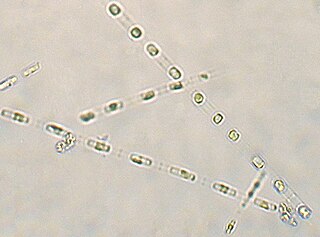
Skeletonema costatum is a cosmopolitan centric diatom that belongs to the genus Skeletonema. It was first described by R. K. Greville, who originally named it Melosira costata, in 1866. It was later renamed by Cleve in 1873 and was more narrowly defined by Zingone et al. and Sarno et al. Skeletonemacostatum is the most well known species of the genus Skeletonema and is often one of the dominant species responsible for red tide events.
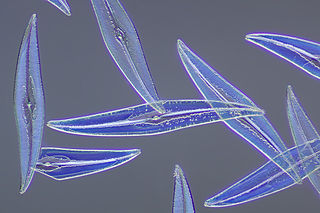
Pleurosigma is a genus of widely distributed diatoms found abundantly in brackish to marine waters. It is a group of primarily pelagic or benthic species found in large populations on sediments, although some species are also found in planktonic samples.











